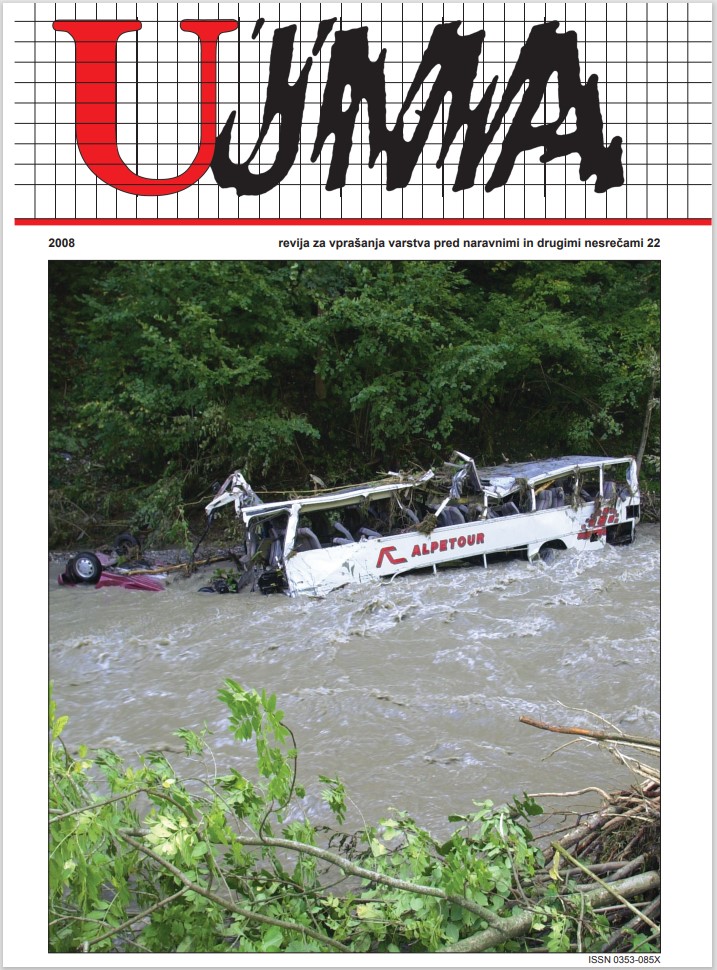HEALTH SERVICE FUNCTION IN THE CASE OF MASS ACCIDENTS
Abstract
Mass accident is every occurrence with a larger number of injured or suddenly sickened persons, which cannot be coped with regular resources (Auf der Heide, 1989). In the world, every day at least one mass accident happens, as distinct from the field of action of the Ambulance Station of the University Medical Centre Ljubljana, where in the last 40 years 11 mass accidents have happened (Fink, 2003). Success of intervention at the mass accident depends on efficient preparations for such an occurrence. General organisation scheme of health service action in mass accidents divides organisation of health service action into pre-hospital and hospital environment. In the pre-hospital environment, a health service working site is established on the site of the emergency or in close proximity, representing a space where all key elements are set and executed, which are important for successful salvation at the mass accidents (Hodgetts and Mackway-Jones, 2002). The key element of the health service working site at the mass accident might be represented by a single person only or one person performing the function of several key elements in the case of small-scale accidents. In the case of large[1]scale accidents, several people who distribute the work among themselves are needed for a successful function of individual key elements. In such a case, coordination of these elements' functioning and coordination of work of the people within each of the elements are of key significance (Furberg, 2006). In the hospital environment, the hospital emergency plan is activated and organisation and operation of the hospital are adjusted to the scale of the mass accident.
References
Auf der Heide, E., 2006. The Importance of Evidence-Based Disaster Planning. Annals of Emergency Medicine, 47(1), 34–49.
Auf der Heide, E., 1989. Disaster Response: Principles of Preparation & Coordination. Pridobljeno 28. 4. 2008 iz http://orgmail2.coe-dmha.org/dr/PDF/DisasterResponse.pdf.
Bern, I. A., 2006. Role of Emergency Medicine in Disaster Management. V: G. R. Ciottone, P. D. Anderson, E. Auf der Heide, R. G. Darling, I. Jacoby, E. Noji in S. Suner (uredniki.), Disaster Medicine (str. 26–33). Philadelphia: Mosby Elsevier.
Becker, S. B., Rehab, Ops. Journal of Emergency Medical Services 2000; zv. 25, št. 11: 37–49.
Chaffe, M. W. in Oster, N. S., 2006. The Role of Hospitals in Disaster. Disaster medicine. Ur. Ciottone, G. R. Mosby Elsevier. Philadelphia 2006. 34–43.
Christen, T. H., Denney, P. J., Maniscalco, M. P., et al., 1999. Terrorism III. Journal of Emergency Medical Services 1999; zv. 24, št. 1: 58–70.
Christen, H. T., Maniscalco, M. M., 1998. EMS Incident Management System, The: Operations for Mass Casualty and High Impact Incidents. 1. izd. Prentice Hall: 1998, 112–130.
County of Orange Health Care Agency Emergency Medical Services. The Hospital Emergency Incident Command System. 5. izd. 2003.
Černelič, F., 1997. Ukrepanje ob nezgodi z nevarno snovjo. Gasilska zveza Slovenije, 1997.
Dickinson, E., 2000. Refuel-Recharge-Rehab. Journal of Emergency Medical Services 2000; zv. 25, št. 11: 25–36.
Fink, A.,2003. Mass Casualty Incident Management System of Ljubljana Ambulance Service. International Conference – Urban Crisis Management in Europe at the Beginning of the 3rd Millenium. Vienna: City of Vienna Office for Crisis Management and Emergency Measures, 2003: 70–81.
Fink, A., 1999. Priprave KC, Reševalne postaje na masovno nesrečo. Urgentna medicina – izbrana poglavja 5. Slovensko združenje za urgentno medicino, 1999; 5: 481–486.
Furberg, R. D. in Marcozzi, D. E., 2006. The Role of Emergency Medical Services (EMS) in Disaster. Disaster medicine. Ur. Ciottone, G. R., Mosby Elsevier. Philadelphia 2006. 20–26.
Hodgetts, T. J. in Mackway-Jones, K. (urednika), 2002. Major Incident Medical Management and Support (2. izd.). London: BMJ Books.
Univerzitetni klinični center Ljubljana – Reševalna postaja. Načrt zaščite in reševanja ob masovnih nesrečah; 2001.
Kaiser Foundation Health Plan, Inc., 2001. Medical Center Hazard and Vulnerability Analysis. Pridobljeno 30. 4. 2008 iz www.gnyha.org/22/file.aspx.
Keim, E. M. in Giannone, P., 2006. Disaster Preparedness. V: G. R. Ciottone, P. D. Anderson, E., Auf der Heide, R. G. Darling, I. Jacoby, E. Noji in S. Suner (uredniki.), Disaster Medicine (str. 164–173). Philadelphia: Mosby Elsevier.
Maniscalco, M. P., Christen, T. H., Rubin, L. D., et al., 1998. Terrorism I. Journal of Emergency Medical Services 1998; zv. 23, št. 11: 38–52.
Maniscalco, M. P., Christen, T. H., Rubin, L. D., et al., 1998. Terrorism II. Journal of Emergency Medical Services 1998; zv. 23, št. 12: 28–40.
Maniscalco, M. P. in Christen, T. H., 2002. Understanding Terrorism and Managing the Consequences. New Jersey: Prentice Hall.
McFee, R. in Leikin, J. B., 2005. Radiation terrorism. Journal of Emergency Medical Services 2005; zv. 30, št. 4: 78–92.
McMahon, A. P., Wright, J. C. in Grey, L. G., 1997. Recommended Practice for Responding to Hazardous Materials Incidents. National Fire Protection Association, 1997.
McMahon, A. P., Wright, J. C., Grey, L. G., 1997. Standard for Competencies for EMS Personel Responding to Hazardous Materials Incidents. National Fire Protection Association, 1997.
Mechem, C. C., 2007. Surge Capacity. Journal of Emergency Medical Services, 32, 48–50.
Michos, B. M., 1997. EMS Sector Standard Operating Procedures. National Fire Protection Association, 1997.
Miller, G. T., Scott, J. A., Gordon, D. L., Issenberg, S. B., in Brotons, A. A., 2003. Training for Acts of Terrorism. Journal of Emergency Medical Services 2003; zv. 28, št. 9: 48–55.
Miller, G. T., Scott, J. A., Brotons, A. A. in Gordon, D. L., 2005. Bioterrorism – EMS response to deadly infections. Journal of Emergency Medical Services 2005; zv. 30, št. 30: 70–81.
National Fire Protection Association, Guidelines for Decontamination of Fire Fighters and Their Equipment Following Hazardous Materials Incidents, 1997.
Phillips, J. S., in Knebel, A., 2007. Mass Medical Care with Scarce Resources: A Community Planning Guide. Pridobljeno 6. 11. 2007 iz http://www.ahrq. gov/research/mce/mceguide.pdf.
Suprun, S. C., 2003. Nerve Agent Attack. Journal of Emergency Medical Services 2003; zv. 28, št. 10: 60–71.
Downloads
Published
Issue
Section
License

This work is licensed under a Creative Commons Attribution-NonCommercial-NoDerivatives 4.0 International License.
The articles are made available to the public under Creative Commons Attribution-NonCommercial-NoDerivatives 4.0 International (CC BY-NC-ND 4.0).


